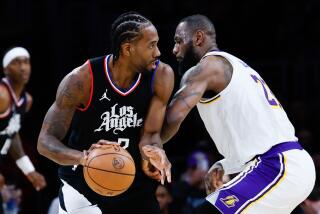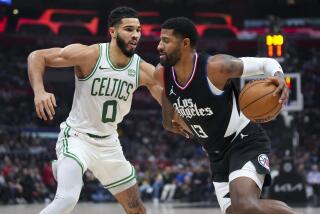Zone Isn’t Forbidden, and Can Be Dangerous
- Share via
With his team on the run after blowing a double-digit second-half lead against Portland on Wednesday night at Staples Center, Coach Alvin Gentry switched the Clippers to a zone defense late in the fourth quarter.
The Trail Blazers, who led by a point, seemed to be caught off guard by Gentry’s 1-2-2 and settled for a three-point shot by Bonzi Wells, which was closely contested by the Clippers’ Quentin Richardson.
Wells’ shot barely nipped the rim but because the Clippers were in a zone, they failed to box out and the Trail Blazers ended up with the rebound and eventually won the game, 97-93.
The Clippers did not lose because of their zone, but they didn’t win with it, either. Which basically sums up the NBA’s growing relationship with a long-forbidden defense that was approved in 2001.
Last season, Minnesota was the league’s bellwether for zone defenses but the Timberwolves learned that it’s difficult to win with a zone over the long haul. In a five- or seven-game playoff series, a zone becomes easier to pick apart.
But this season, more teams are turning to zones and that may be one reason the league scoring average is only 97.2. Dallas, New Jersey, Seattle, Minnesota and even the Clippers have gotten a lot of mileage out of multiple zone defenses.
Are zone defenses effective against superstar players? Yes, especially if you have plenty of size to line up around the lane to slow dribble penetration.
Because more coaches are using unconventional zones, ranging from a box-and-one (a 2-2 zone with one defender playing man to man) to a 1-3-1 trap (a defense that double-teams the ball), talented scorers are facing difficult challenges every night. Just ask the Lakers’ Shaquille O’Neal and Kobe Bryant.
The NBA emphasizes individual talent and high-powered offensive players are going to get their points. But zones make them rely more on their teammates and that’s not always good.
Offenses tend to fall apart when the ball has to be reversed around the court a few times and players have to change positioning. The shot clock runs down, resulting in forced shots. Even talented scorers such as Tracy McGrady, Allen Iverson and Bryant look average when they have to hoist up a bad shot to beat the 24-second clock.
Why are more teams using zones? Because many of today’s NBA players can’t shoot.
Just look at some of the futility records set already this season. The Lakers set a franchise record for lowest field-goal percentage in a game twice within a month. Denver and Detroit put up the lowest halftime score in NBA history, 29-28, which broke a record set in the pre-shot clock days of 1955. Maybe the best example of brick shooting was the Nuggets’ scoring only three points in the first quarter of a game against San Antonio.
Zones make offensive players think and play together as a five-man unit. Which doesn’t happen too often in a league filled with young players who don’t know how to move without the ball, or take good percentage shots.
That’s how the Clippers, who certainly have plenty of holes in their zone defenses, won a couple of games this season.
Another plus for zones is that they often leave the perimeter open, not a bad idea, considering the modern NBA player grew up watching highlight dunks on “SportsCenter.”
Only seven teams are shooting better than 45%, and four, one of them the Lakers, are not even shooting 40%. Six teams are making less than 30% from behind the three-point arc, so it’s easy to understand why the term “self-check” has become so popular.
Why doesn’t every team play a zone? Because it takes a lot of work and familiarity to play it effectively.
The concept of defending an area of the floor instead of guarding a man is a tough adjustment for many of today’s players, who often lack the knowledge of basic defensive principles.
In a recent game against Houston, Indiana played a variety of zones, hoping to slow Rocket center Yao Ming. It didn’t work. Yao finished with 29 points and 10 rebounds and the Rockets dominated on the boards, 60-34, getting 25 rebounds on the offensive end.
Another reason teams don’t play more zones is the three-second limit for defenders in the paint. This prevents defenses from placing players under the basket and allows for more cuts through the lane.
*
(BEGIN TEXT OF INFOBOX)
Zone Improvement
The Dallas Mavericks have benefited the most from the zone defense. Last season, the Mavericks averaged 105.2 points but gave up 101.0. This season, the Mavericks -- with the help of the zone -- are allowing 92.6 points and scoring 104.9. A look at teams’ scoring averages and field-goal percentages (through Thursday’s games):
*--* POINTS PER GAME FIELD GOAL PCT Team Own Opp Own Opp Dallas 104.9 92.6 457 420 Milwaukee 100.4 99.3 455 440 Sacramento 98.7 91.6 458 424 Golden State 98.5 100.7 425 446 Orlando 97.8 99.2 431 457 Indiana 97.8 93.2 453 420 Boston 97.1 94.6 421 425 New Jersey 97.1 89.2 443 414 Atlanta 96.0 98.8 446 433 New Orleans 95.6 92.6 439 449 Minnesota 95.6 95.6 446 425 Memphis 95.1 101.0 450 464 Philadelphia 95.0 91.7 442 442 Seattle 94.2 93.1 449 442 Utah 94.1 91.7 460 425 LAKERS 93.2 96.3 420 434 New York 93.0 96.1 435 449 Chicago 93.0 98.2 433 439 CLIPPERS 92.8 95.2 443 435 Houston 91.8 89.0 436 423 San Antonio 91.4 87.7 442 408 Washington 91.3 89.2 447 439 Cleveland 91.0 101.8 415 464 Portland 90.9 89.3 449 434 Toronto 89.0 95.7 410 464 Phoenix 88.8 89.8 415 428 Detroit 88.3 84.5 433 420 Miami 84.9 90.2 404 437 Denver 79.9 88.7 391 440
*--*
More to Read
Go beyond the scoreboard
Get the latest on L.A.'s teams in the daily Sports Report newsletter.
You may occasionally receive promotional content from the Los Angeles Times.






